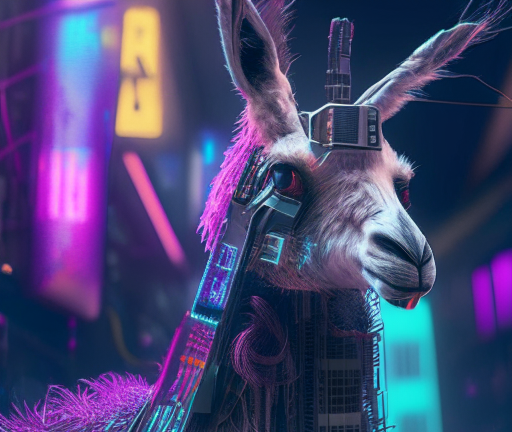poet-vicuna-13b
Maintainer: replicate

1
⚙️
| Property | Value |
|---|---|
| Run this model | Run on Replicate |
| API spec | View on Replicate |
| Github link | View on Github |
| Paper link | No paper link provided |
Create account to get full access
Model overview
poet-vicuna-13b is an instruction-tuned large language model (LLM) developed by Replicate that allows you to constrain syllable patterns in the generated text. It is based on the open-source LLaMA-13B model from Meta Research, which has been further trained on user-shared conversations collected from ShareGPT. According to the developers, poet-vicuna-13b outperforms comparable models like Stanford Alpaca and reaches 90% of the quality of OpenAI's ChatGPT and Google Bard.
Model inputs and outputs
poet-vicuna-13b takes in a variety of inputs that allow you to customize the generated text, including the prompt, the initial text to use as a template, the desired maximum length, temperature, and more. The model outputs a string of generated text that adheres to the specified syllable pattern.
Inputs
- Prompt: The text prompt to send to the model
- Init Text: Text to initialize the metric constraints with, determining the syllable pattern
- Max Length: The maximum number of tokens to generate
- Syllable Pattern: A space-delimited pattern of syllables for each line, using 0 to represent a new line
- Temperature: Adjusts the randomness of the outputs
- Repetition Penalty: Penalty for repeated words in the generated text
Outputs
- Output: The generated text that follows the specified syllable pattern
Capabilities
poet-vicuna-13b is capable of generating coherent and creative text while adhering to specific syllable patterns. This could be useful for writing poetry, song lyrics, or other forms of structured text. The model's ability to reach 90% of the quality of ChatGPT and Bard suggests it is a powerful language model that can handle a variety of tasks.
What can I use it for?
poet-vicuna-13b could be used for a variety of creative writing tasks, such as:
- Generating original poetry or song lyrics with a specific syllable structure
- Assisting in the writing of haikus, limericks, or other forms of structured verse
- Producing text for greeting cards, advertisements, or other marketing materials with a distinctive cadence
- Exploring the creative potential of constrained writing exercises
Things to try
Try experimenting with different prompts and syllable patterns to see the range of text poet-vicuna-13b can produce. You could also try using the model to generate text for a specific poetic form, such as a sonnet or a villanelle, and see how well it captures the structure and rhythm of those forms.
This summary was produced with help from an AI and may contain inaccuracies - check out the links to read the original source documents!
Related Models

vicuna-13b

251
vicuna-13b is an open-source large language model (LLM) developed by Replicate. It is based on Meta's LLaMA model and has been fine-tuned on user-shared conversations from ShareGPT. According to the provided information, vicuna-13b outperforms comparable models like Stanford Alpaca, and reaches 90% of the quality of OpenAI's ChatGPT and Google Bard. Model inputs and outputs vicuna-13b is a text-based LLM that can be used to generate human-like responses to prompts. The model takes in a text prompt as input and produces a sequence of text as output. Inputs Prompt**: The text prompt that the model will use to generate a response. Seed**: A seed for the random number generator, used for reproducibility. Debug**: A boolean flag to enable debugging output. Top P**: The percentage of most likely tokens to sample from when decoding text. Temperature**: A parameter that adjusts the randomness of the model's outputs. Repetition Penalty**: A penalty applied to repeated words in the generated text. Max Length**: The maximum number of tokens to generate in the output. Outputs Output**: An array of strings representing the generated text. Capabilities vicuna-13b is capable of generating human-like responses to a wide variety of prompts, from open-ended conversations to task-oriented instructions. The model has shown strong performance in evaluations compared to other LLMs, suggesting it can be a powerful tool for applications like chatbots, content generation, and more. What can I use it for? vicuna-13b can be used for a variety of applications, such as: Developing conversational AI assistants or chatbots Generating text content like articles, stories, or product descriptions Providing task-oriented assistance, such as answering questions or providing instructions Exploring the capabilities of large language models and their potential use cases Things to try One interesting aspect of vicuna-13b is its ability to generate responses that capture the nuances and patterns of human conversation, as it was trained on real user interactions. You could try prompting the model with more open-ended or conversational prompts to see how it responds, or experiment with different parameter settings to explore the model's capabilities.
Updated Invalid Date

vicuna-7b-v1.3

28
The vicuna-7b-v1.3 is a large language model developed by LMSYS through fine-tuning the LLaMA model on user-shared conversations collected from ShareGPT. It is designed as a chatbot assistant, capable of engaging in natural language conversations. This model is related to other Vicuna and LLaMA-based models such as vicuna-13b-v1.3, upstage-llama-2-70b-instruct-v2, llava-v1.6-vicuna-7b, and llama-2-7b-chat. Model inputs and outputs The vicuna-7b-v1.3 model takes a text prompt as input and generates relevant text as output. The prompt can be an instruction, a question, or any other natural language input. The model's outputs are continuations of the input text, generated based on the model's understanding of the context. Inputs Prompt**: The text prompt that the model uses to generate a response. Temperature**: A parameter that controls the model's creativity and diversity of outputs. Lower temperatures result in more conservative and focused outputs, while higher temperatures lead to more exploratory and varied responses. Max new tokens**: The maximum number of new tokens the model will generate in response to the input prompt. Outputs Generated text**: The model's response to the input prompt, which can be of variable length depending on the prompt and parameters. Capabilities The vicuna-7b-v1.3 model is capable of engaging in open-ended conversations, answering questions, providing explanations, and generating creative text across a wide range of topics. It can be used for tasks such as language modeling, text generation, and chatbot development. What can I use it for? The primary use of the vicuna-7b-v1.3 model is for research on large language models and chatbots. Researchers and hobbyists in natural language processing, machine learning, and artificial intelligence can use this model to explore various applications, such as conversational AI, task-oriented dialogue systems, and language generation. Things to try With the vicuna-7b-v1.3 model, you can experiment with different prompts to see how the model responds. Try asking it questions, providing it with instructions, or giving it open-ended prompts to see the range of its capabilities. You can also adjust the temperature and max new tokens parameters to observe how they affect the model's output.
Updated Invalid Date

vicuna-13b-v1.3

35
The vicuna-13b-v1.3 is a language model developed by the lmsys team. It is based on the Llama model from Meta, with additional training to instill more capable and ethical conversational abilities. The vicuna-13b-v1.3 model is similar to other Vicuna-based models and the Llama 2 Chat models in that they all leverage the strong language understanding and generation capabilities of Llama while fine-tuning for more natural, engaging, and trustworthy conversation. Model inputs and outputs The vicuna-13b-v1.3 model takes a single input - a text prompt - and generates a text response. The prompt can be any natural language instruction or query, and the model will attempt to provide a relevant and coherent answer. The output is an open-ended text response, which can range from a short phrase to multiple paragraphs depending on the complexity of the input. Inputs Prompt**: The natural language instruction or query to be processed by the model Outputs Response**: The model's generated text response to the input prompt Capabilities The vicuna-13b-v1.3 model is capable of engaging in open-ended dialogue, answering questions, providing explanations, and generating creative content across a wide range of topics. It has been trained to be helpful, honest, and harmless, making it suitable for various applications such as customer service, education, research assistance, and creative writing. What can I use it for? The vicuna-13b-v1.3 model can be used for a variety of applications, including: Conversational AI**: The model can be integrated into chatbots or virtual assistants to provide natural language interaction and task completion. Content Generation**: The model can be used to generate text for articles, stories, scripts, and other creative writing projects. Question Answering**: The model can be used to answer questions on a wide range of topics, making it useful for research, education, and customer support. Summarization**: The model can be used to summarize long-form text, making it useful for quickly digesting and understanding complex information. Things to try Some interesting things to try with the vicuna-13b-v1.3 model include: Engaging the model in open-ended dialogue to see the depth and nuance of its conversational abilities. Providing the model with creative writing prompts and observing the unique and imaginative responses it generates. Asking the model to explain complex topics, such as scientific or historical concepts, and evaluating the clarity and accuracy of its explanations. Pushing the model's boundaries by asking it to tackle ethical dilemmas or hypothetical scenarios, and observing its responses.
Updated Invalid Date

instructblip-vicuna13b

257
instructblip-vicuna13b is an instruction-tuned multi-modal model based on BLIP-2 and Vicuna-13B, developed by joehoover. It combines the visual understanding capabilities of BLIP-2 with the language generation abilities of Vicuna-13B, allowing it to perform a variety of multi-modal tasks like image captioning, visual question answering, and open-ended image-to-text generation. Model inputs and outputs Inputs img**: The image prompt to send to the model. prompt**: The text prompt to send to the model. seed**: The seed to use for reproducible outputs. Set to -1 for a random seed. debug**: A boolean flag to enable debugging output in the logs. top_k**: The number of most likely tokens to sample from when decoding text. top_p**: The percentage of most likely tokens to sample from when decoding text. max_length**: The maximum number of tokens to generate. temperature**: The temperature to use when sampling from the output distribution. penalty_alpha**: The penalty for generating tokens similar to previous tokens. length_penalty**: The penalty for generating longer or shorter sequences. repetition_penalty**: The penalty for repeating words in the generated text. no_repeat_ngram_size**: The size of n-grams that cannot be repeated in the generated text. Outputs The generated text output from the model. Capabilities instructblip-vicuna13b can be used for a variety of multi-modal tasks, such as image captioning, visual question answering, and open-ended image-to-text generation. It can understand and generate natural language based on visual inputs, making it a powerful tool for applications that require understanding and generating text based on images. What can I use it for? instructblip-vicuna13b can be used for a variety of applications that require understanding and generating text based on visual inputs, such as: Image captioning: Generating descriptive captions for images. Visual question answering: Answering questions about the contents of an image. Image-to-text generation: Generating open-ended text descriptions for images. The model's versatility and multi-modal capabilities make it a valuable tool for a range of industries, such as healthcare, education, and media production. Things to try Some things you can try with instructblip-vicuna13b include: Experiment with different prompt styles and lengths to see how the model responds. Try using the model for visual question answering tasks, where you provide an image and a question about its contents. Explore the model's capabilities for open-ended image-to-text generation, where you can generate creative and descriptive text based on an image. Compare the model's performance to similar multi-modal models like minigpt-4_vicuna-13b and instructblip-vicuna-7b to understand its unique strengths and weaknesses.
Updated Invalid Date